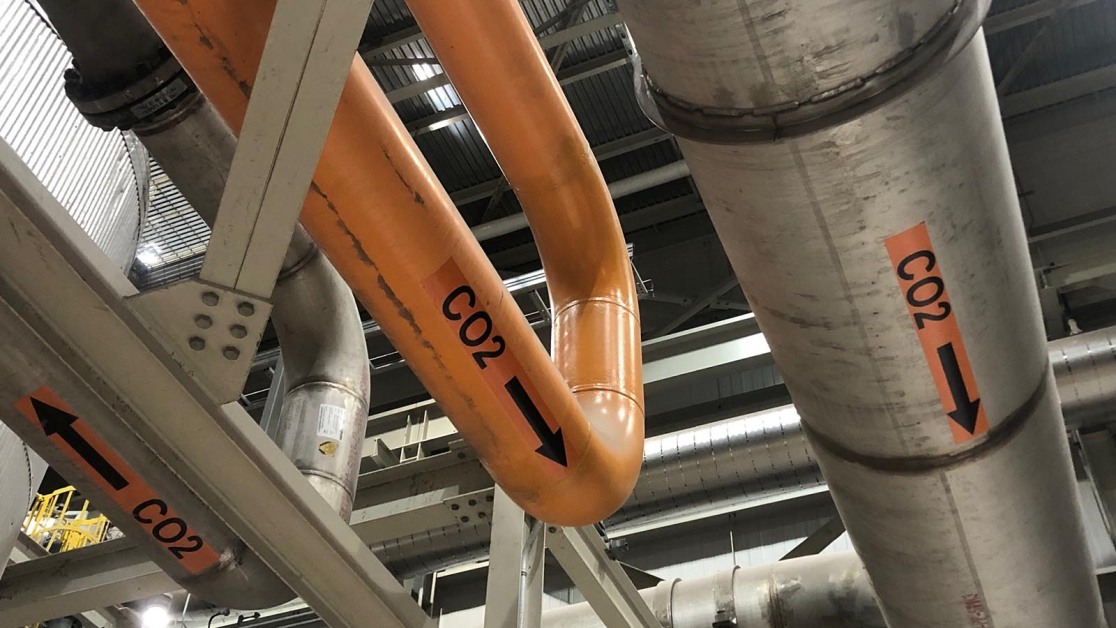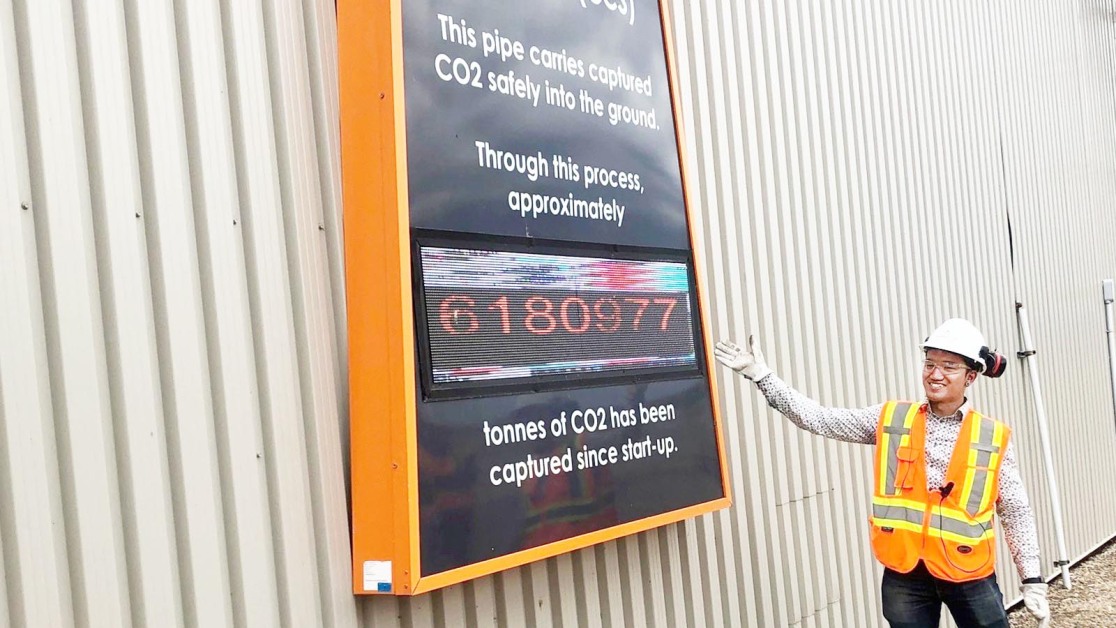If you were tasked with coming up with a way to reduce emissions in Canada at a massive scale, do you know what you would do?
Here are a few scenarios to consider:
Scenario one
Stop everything that creates emissions. That includes halting production of things like iron, steel, cement and energy (to name a few), because they emit carbon dioxide (CO₂) into the atmosphere when they are manufactured.
This option is obviously not practical because we rely on energy and products for our daily lives, they contribute to our prosperity and growth as a nation and industries that use these resources create a lot of jobs.
Scenario two
Look for alternatives for anything that emits CO₂.
This is already happening in the energy space with technologies such as wind and solar power, for example. The problem is, they don’t generate nearly enough reliable energy to meet our needs, storage can be a challenge and they occupy a lot of land. And no wind, or a cloudy sky means no energy, so a diverse energy mix is important for energy reliability.
There are some technologies on the horizon such as small modular nuclear reactors and hydrogen that have low, or little-to-no emissions. These options, however, are not fast to develop and deploy, and they’re a long way away from being ready at scale.
Scenario three
Find ways to reduce or eliminate emissions from existing processes while still producing energy or manufacturing. For example, we could take the CO₂ emissions created in fossil fuel, steel or cement production and store them somewhere, so they aren’t released into the atmosphere.
There are tradeoffs in every scenario, and all of the options take a considerable amount of time, so a pragmatic approach that thoughtfully considers the pros and cons (while offering balance) is what we know engaged women want.
In this case, scenario three effectively balances the immediate need to produce and use energy in both our daily living and manufacturing, while also caring for the environment.
And fortunately, this technology already exists today. It’s called carbon capture and storage (CCS), and it’s an important part of our country’s approach to reducing emissions.

Photo courtesy International CCS Knowledge Centre
What is CCS and why do engaged women care about it?
In a nutshell, CCS involves three steps:
- Capture: CO₂ is separated from other gases at industrial facilities like steel mills, cement plants and during energy production, including oil and gas operations.
- Transport: The separated CO₂ is compressed into a liquid-like state, dehydrated, and then transported mainly via pipelines.
- Storage: The CO₂ is injected into deep underground rock formations, similar to those that have stored oil and gas for millions of years. The rock layer acts as a permanent, natural seal to keep the carbon from being emitted.
These steps ensure the greenhouse gas is not released into the atmosphere.
It’s for this reason that CCS is a leading strategy for reducing emissions in Canada and elsewhere around the world, and it’s a technology that many Canadian women are getting behind.
According to new research done by Leger on behalf of Canada Powered by Women, nearly half (45 per cent) of engaged women in the country said they think CCS is a good way to meet emissions-reduction targets. If we include those who are neutral or don’t have an opinion on this yet, the number jumps to 79 per cent of engaged women.
For these women, a healthy environment is a priority but it can’t come at the cost of a healthy economy, good jobs and quality of life for Canadians.
CCS is viewed as offering a balance of all of the above — and the good news is that we have a lot of places to store CO₂.
Canada’s carbon capture competitive advantage
“In places like Canada, there are abundant CO2 storage resources,” says Beth (Hardy) Valiaho, vice-president of public affairs and international engagement at the International CCS Knowledge Centre.
“In Western Canada, there’s just under 400 billion tonnes of storage opportunities.”
For context, that is roughly equivalent to the volume of 160 million Olympic-sized swimming pools, which could hold nearly 10 times more than all of the global emissions in 2023 (410 million tonnes).
Valiaho notes that CCS is an important technology for reducing emissions across a variety of sectors.
“It is really important to consider that CCS can be used not just on energy, [but for] things like iron, steel and cement,” Valiaho says. “You’re always going to need cement, you’re always going to need iron and steel, and those things don’t have other ways to reduce emissions other than CCS.”

Canada needs a clear policy framework and incentives around CCS
Infrastructure investment to bring more CCS to life is what’s needed, Valiaho says.
“Right now, in the world there are only 41 CCS facilities. There are a number that are being announced to happen in the next few years, but we really need to get them going in order for them to be part of a net-zero solution.”
Canada is already a leader in CCS. Since 2000, projects in Saskatchewan and Alberta have safely stored more than 50 million tonnes of CO₂ that would have otherwise been emitted to the atmosphere. That’s the equivalent of taking more than 11 million cars off the road.
Another large-scale CCS project planned to be built in Alberta is led by the Pathways Alliance. The $16.5-billion carbon capture project will help reduce emissions from oil sands operations by 32 per cent from 2019 emissions levels by 2030.
A critical part of speeding up CCS project development is government incentives.
The United States is often cited for its fiscal incentives and clear policy to encourage CCS project development, offering a tax credit of $85 for every tonne of CO₂ captured and stored underground. This tax credit is tied specifically to the amount of CO₂ captured and stored rather than upfront capital expenditures and it was put in place to encourage the adoption of CCS technologies by making it more economically viable for companies to invest in carbon capture initiatives.
The Canadian Investment Tax Credit (ITC), by comparison, is a federal refundable tax credit that can be applied to expenses related to capturing, transporting and storing CO₂. Announced in 2021, the ITC has yet to formally roll out. When it does, it is meant to offset the enormous capital costs associated with CCS projects similar to the tax credit provided in the United States.
There are also provincial incentives in Alberta and Saskatchewan that provide financial rewards for capturing CO₂ and some offer direct funding, regulatory support, and partnerships. These provincial incentives work alongside federal programs to make CCS more financially viable and encourage industries to reduce their carbon emissions.
While there has been CCS support from different levels of government, many observers and those working in the energy industry have been frustrated at the pace of development of ITC support and critics say it’s been too slow to roll out.
At a media event in April, Shell Canada head Susannah Pierce said investment tax credits are needed so the industry can decide on major investments in the country.
“It is critical and we’re waiting for that to happen,” Pierce said. “And it’s crucial that it happens as soon as it can. Otherwise, we will not be able to make the investments that I really want to see happen in Canada. So that is really, really critical, getting those fiscal incentives in place in a timely manner. Otherwise, capital goes someplace else.”
And going someplace else does happen.
In May, Capital Power cancelled its $2.4-billion CCS project near Edmonton, saying it was no longer financially feasible. That project was technically viable but not economically feasible, even with current government subsidies, Capital Power said.
“We’ve seen a lack of federal investment and some uncertainty based on some of the policies the federal government has rolled out,” Alberta environment minister, Rebecca Schulz, told the CBC after news of the cancellation broke.
Schulz said the federal government did not follow through on subsidies it promised, including investment tax credits, and those are important to make these expensive projects more economically viable.
What this can mean for Canada is that the technology, innovation, spending power, job creation, and emissions-reduction efforts that would have come with the project will move to other places in the world where investment criteria are more clear and favourable.

Photo courtesy International CCS Knowledge Centre
More women are getting involved in CCS
“CCS is a great technology,” says Valiaho. “I have a master’s in climate change law and this is something I’ve always been very interested in.”
For Valiaho, having options to help reduce emissions is important, and CCS is one of those tools in the toolbox. She also sees a chance to bring more diverse viewpoints to the table when it comes to how CCS rolls out.
“I see a lot of opportunities for women in this area. It’s a sector that leans traditionally male, but I have been very fortunate to be able to travel the world to talk about this technology and I see more and more brilliant women wanting to get involved because they see this as a very viable solution.”
